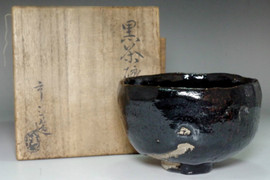Raku Kichizaemon 13th Seinyu (1887-1944) Antique kuro-raku tea bowl #4536
- SKU:
- 4536
- Shipping:
- Free Shipping
- width: approx. 11cm (4 21⁄64in)
- height: approx. 7.4cm (2 29⁄32in)
- weight: 303g (gross 492g)
- writing on the box: black raku tea bowl made by Raku Seinyu
Raku Kichizaemon 13th Seinyu
1887-1944
male
raku pottery
Born as the eldest son of Konyu who was 12th generation in his family. His birth name was Sokichi, and he was later renamed Yoshihide. In 1919, he succeeded the family at age 33 after Konyu retired. In 1944, he died without retiring at age 58. Seinyu loved tea ceremony from the bottom of his heart and worked hard for the prosperity of the culture of the tea ceremony. He published a series of research journals on tea ceremony called “Sado seseragi” between 1935 and 1942, which was a groundbreaking attempt for both research on tea ceremony and enlightenment, and to this day the importance of the content of its research and the documents are still highly regarded. Additionally, he energized tea ceremony as the head of the Senkejishoku (ten craftsmen related to the tea ceremony) by holding tea ceremonies every sixth day of the month (eve of the day of Chojiro’s death) and he even held one two days before his death.
Other than tea ceremony, he also enjoyed haiku (Japanese poetry), drawing, and Noh theater. He also enjoyed classic Chinese literature and in particular he studied Teranishi Kenzan’s works and left some of his own Chinese poetry. He showed interest in western art and it is said that he dreamed of studying in France, and he is thought to have studied French on his own.
He was close friends with the 12th Omotesenke, Seisai, and the kanji for “Sein” in Seinyu was gifted by him. Times were harsh during Seisai’s time. As the era changed from Keinyu to Konyu, the world of tea ceremony also became more energetic, but with the First and Second World Wars he was unable to get charcoals for kiln in his later years. In 1941 his eldest son Yoshihisa was conscripted during the Second World War and he was stationed in Manchuria. Seisai dies before Yoshihisa returns, but in such times of chaos and hardship, Seisai still protected the tradition of Raku tea bowl and served an important role in ensuring it was passed down to future generations.
His art style is consevative and it is in the traditional style of the Raku tea bowl which was started by Chojiro. It does not show much individual character or variety, but he has been able to be expressive through the traditional shape of the Raku tea bowls. This is especially apparent in his research of glaze and he continued his experiments by collecting ores from different regions. The result of this lies in the new glaze style, and there are many works of his that has this. His works include Jakatsu-gusuri (snake’s scale glaze) which can be seen in the black Raku tea bowl called “Araiso”, the ore glaze which uses ore from Mitsui Kashima mines, and the flower vase which uses the yakinuki baking method. Other than tea bowls, he enthusiastically worked on making other tea ceremony tools such as pitchers, flower vases, and dishes, as well as objects such as the statue of the god of longevity and Tenjin (Sugawara no Michizane). His works include the black Raku tea bowl called “Araiso” and “Wakakusa”, and hand baked incense burner in the shape of a rabbit.

















